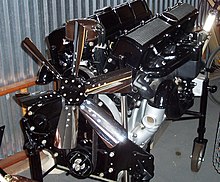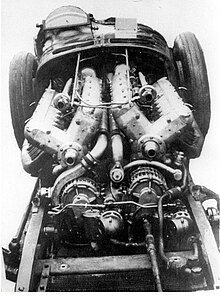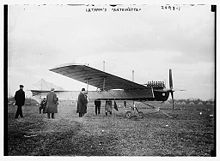V16 engine

AV16 engineis a sixteen-cylinderpiston enginewhere two banks of eight cylinders are arranged in aV configurationaround a common crankshaft. V16 engines are less common than engines with fewer cylinders, such as V8 and V12 engines. Each bank of a V16 engine can be thought of as astraight-eight,a design that can be inherentlybalanced.Most V16 engines have a 45° bank angle.
The first use of a V16 engine was in the 1910Antoinette VIIexperimental aircraft, followed by several cars in the 1930s. Today, the most common applications for V16 engines are railroad locomotives, marine craft, and stationary power generators.
Automotive applications[edit]
Production cars[edit]

The first production car to use a V16 engine was theCadillac V-16,introduced in January 1930. TheCadillac V16 enginewas initially produced with a displacement of 452 cu in (7.4 L),OHVand a V-angle of 45 degrees. For the 1938Series 90,the engine was revised to a displacement of 431 cu in (7,062.8 cm3), aflathead valvetrainand a V-angle of 135 degrees (the latter in order to achieve a lower cowl height). This 431 cu. in. version produced as much power as its immediate predecessor while being far less complex, had a stiffer crankshaft that aided durability and smoothness, and even had an external oil filter, a rarity for any car at any price in those days.
TheMarmon Motor Car Companyactually began development of a V16 engine in 1927 (earlier than Cadillac). Its development program took longer, however, and theMarmon Sixteenwas released in 1931. This engine had a V-angle of 45 degrees, used pressed steelcylinder linersand was constructed mostly of aluminium. Only 400 Marmon Sixteens were produced between 1931 and 1933. In 1991, theCizeta-Moroder V16Tbegan production, featuring a 16-cylinder engine in a unique configuration. Rather than a conventional V16 layout, the engine was actually two separatetransversely mountedV8 engines with gearing between the two providing a single output from the centre of the engine assembly to the transmission. Only a few cars were produced before the company ceased operations. In June 2024,Bugattiunveiled the successor to theChiron(which has aW16 Engine), theTourbillon,which houses a V16 8.3L (506 cu in) hybrid powertrain co-developed withCosworth.[1]
Prototype cars[edit]

ThePeerless Motor Companydeveloped a V16 engine in the early 1930s, yet just a single prototype was built before all automobile production ceased and the company converted its factory into a brewery followingthe end of Prohibition in the United States.[2]
In the late 1980s, theBMW Goldfish V166.7 L (409 cu in) engine was developed, based on BMW's then-new V12 engine. Prototypes were fitted to a long-wheelbase 7 Series and then in the early 1990s to aBentley Mulsanne.At around the same time, Mercedes-Benz developed a 8.0 L (488 cu in) V16 engine for the S-class limousine. Between 1988 and 1990, approximately 35 prototypes were built.[3]
The 2003Cadillac Sixteenconcept car was unveiled with a 13.6 L (830 cu in) V16 engine, which was based on the General Motors LS V8 engines.[4]The following year, theRolls-Royce 100EXconcept car was unveiled with a 9.0 L (549 cu in) V16 engine. The car featured in the filmJohnny English Rebornis powered by this V16 engine.
The 2017Devel Sixteen Prototypeused a quad-turbo 12.3 L (751 cu in) V16 engine.[5]
Racing cars[edit]


The first known use of a V16 in motor racing was theMaserati Tipo V4car used in Grand Prix racing.[6]The Tipo V4 debuted at Monza in 1929 and achieved a world speed record of 245.9 km/h (152.8 mph) at an event in Cremona, Italy.[7]
At the1931 Indianapolis 500,a custom-built V16 engine was fitted to aCord"supercar" driven by Shorty Cantlon. The car was competitive, charging from 26th on the grid to 3rd, but was slowed by unreliability, further exacerbated by having to change all sixteen spark plugs. The following year, Bryan Saulpaugh qualified the car in third position. The car suffered a broken oil line on lap 55 and their race was over. Shortly after the race the V16 was removed and replaced with a conventional Miller four-cylinder engine.[8]
The mid-enginedAuto UnionType A,Type BandType CGrand Prix cars of 1933 to 1938 were powered by supercharged 4.4 L (269 cu in) engines. Due to a rule change in 1938, these were replaced by a V12 engine for theType Dracing car. Prior to this rule change, theAlfa Romeo Tipo 316competed at the 1938 Tripoli Grand Prix powered by a 60-degree V16 engine, and in 1939 an unusual 135-degree V16 engine was installed in theAlfa Romeo Tipo 162.[9]
The only known use of a V16 engine in the post-World War II era is theBritish Racing Motors (BRM) V16 engineused in Formula One racing from 1950 to 1955. The engine was a 1.5 L (91 cu in) supercharged design, which was unsuccessful despite its high power output. Officially, it produced 410 kW (550 hp) but probably delivered around 450 kW (600 hp).[10]The car was difficult to drive, due to the power band being in a narrow range and at high RPM.
Marine / rail applications[edit]

This sectionneeds additional citations forverification.(July 2020) |
The V16 configuration is also used in several large displacementdiesel enginesthat are used as marine engines or in raillocomotives.This is due to manufacturers often designing an engine around a fixed displacement percylinder,then adding additional cylinders to the design until the required power output is achieved. For example, theElectro-Motive Diesel 710engine range uses a displacement of 710 cu in (11.6 L) per cylinder, with the 16 cylinder version (called theEMD 16-710) producing over 4,300 hp (3.2 MW).
GE Transportationproduces the7FD Seriesfour-stroke engines (used in marine, locomotive, and stationary applications), which have a displacement of 668 cu in (10.9 L) per cylinder and can produce over 4,400 hp (3.3 MW). GE also manufactures the GEVO-16, which produces over 6,000 hp (4.47 MW).
Another V16 diesel engine is theWärtsilä46F,which produces over 25,700 hp (19.2 MW) at 600 rpm.[11]
In the UK from 1947 onwards,English Electric's subsidiaryEnglish Electric diesel engines[12]developed a V16 engine for rail and marine use based on its 10 "bore x 12" stroke (254mm x 305mm) K series from the 1930s, notably used inBritish Railwaysclass40and50locomotives with power output in the range 2000-3000 hp (1492-2238 kW) at speeds ranging from 600 to 900 rpm. This engine too derives from a series based on a fixed cylinder size of 942 cu.in. (15.4 L) per cylinder, giving the V16 a total capacity of 15,072 cu.in. (246 L).
Another notable maker to offer the V16 configuration wasDetroit Dieselcorporation, especially in their 71, 92 and 149 series2-strokediesel engines, with output ranging from around 650 to over 2400 bhp (485-1790 kW) at speeds over 2000 rpm in the smaller ranges. Once again these engines were based on common parts (the numeric designation is the cylinder size in cubic inches) and were used for maritime, generator and off-road mine truck applications. The modular nature of the engines meant that the V16 configuration was built by putting together two V8 engine blocks and the 2-stroke cycle offered excellent power to weight, with the 16V149 being capable of equalling the output of much larger, slower-running 4-stroke engines.
Fairbanks Morsemanufactures the following V16 diesel engines, FM |ALCO 251F, FM | COLT-PIELSTICK PA6B STC, FM | COLT-PIELSTICK PC2.5 STC, FM | MAN 28/33D STC, FM | MAN 32/44CR, FM | MAN 48/60 CR and the FM | MAN 175D.
Aircraft applications[edit]

The 1910 version of theAntoinette VIIwas powered by a V16 engine and competed in the 1910Gordon Bennett Cupin the United States.[13]
The 1930sHindenburg airshipswere each powered by fourDaimler-Benz DB 602V16 diesel engines.
In the first half of the 20th century, several prototype aircraft used V16 engines, including:
- 1907 prototype designed byAntoinetteengineerLéon Levavasseur.[citation needed]
- Duesenbergdeveloped a V16 engine for use in military aircraft in the mid 1910s. World War I ended prior to the engine being tested in an aircraft.[14]
- TheChrysler IV-2220inverted V16 engine began development in 1939, when Chrysler was contracted by the United States government to create a new engine for use in fighter aircraft. The resulting engine was rated at 2,500 hp (1,900 kW),[citation needed],however it took until June 1945 for the engine to be in a state ready for testing. A prototype engine was installed in aP-47 Thunderbolt(designated theXP-47H),[15]which achieved a top speed of 504 mph (811 km/h). World War II ended shortly after the tests, therefore development of the engine ceased.
See also[edit]
References[edit]
- ^"2026 Bugatti Tourbillon: This Is It".Motor1.com.Retrieved2024-06-21.
- ^Georgano, G. N., ed. (1971). Encyclopedia of American Automobiles (2nd ed.). London: Rainbird Reference Books. pp. 153–154.ISBN0-525-097929.
- ^"Кабанчик с V16 (Mercedes-Benz S800)".www.pikabu.ru(in Russian).Retrieved22 July2020.
- ^"First Drive: Cadillac Sixteen".www.motortrend.com.4 August 2003.Retrieved22 July2020.
- ^Perez, Jeff."5,000-HP Devel Sixteen Could Debut In Dubai With Working Engine".www.motor1.com.Retrieved3 June2020.
- ^"A history of innovation".www.maserati.com.Retrieved22 July2020.
- ^"The Short and Intruiging History of V-16 and W-16 engines".www.topspeed.com.29 June 2020.Retrieved22 July2020.
- ^1931 Miller V16 Racing CarArchived2009-07-12 at theWayback Machine,RM Auctions,Retrieved 2010-06-14
- ^"ALFA ROMEO TIPO 162".alfaklub.dk.Archived fromthe originalon 2008-06-01.Retrieved2007-12-18.
- ^Nye, Doug (2003). BRM: Front Engined Cars, 1945-1960. Volume 1. Motor Racing Publications.ISBN0-947981-37-3.
- ^"Wärtsilä 46F - diesel engine".Wartsila.com.
- ^"English Electric Diesel Engines - Graces Guide".www.gracesguide.co.uk.Retrieved2020-10-14.
- ^Hartmann Gerard (2007-08-05)."Les moteurs et aéroplanes Antoinette"[Antoinette engines and aeroplanes](PDF)(in French). Archived fromthe original(PDF)on 2014-12-14.Retrieved2009-11-08.
- ^Thomas, Dave (2009-05-24)."Duesenberg V16 Aircraft Engine".PBase.com.Retrieved2017-07-14.
- ^"IV-2220 at Walter P. Chrysler Museum, Auburn Hills, Michigan".Enginehistory.org.Retrieved2011-11-25.

